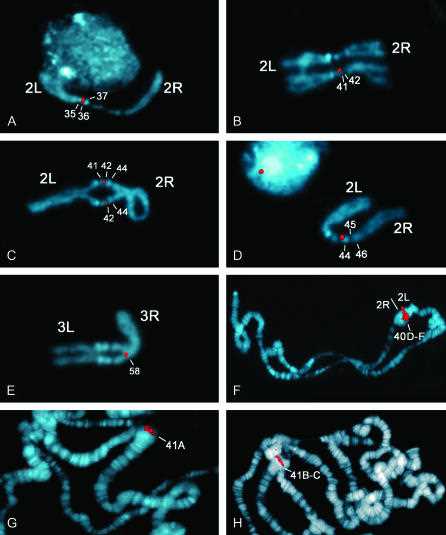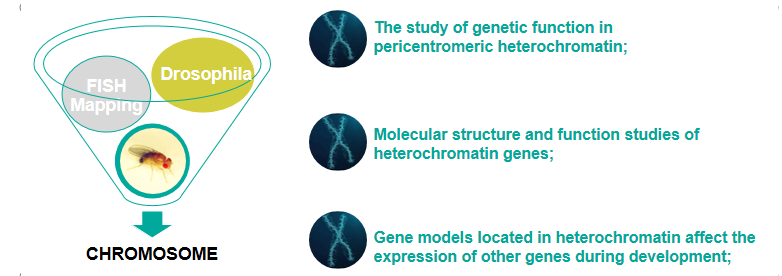Drosophila Mitotic Heterochromatin
Creative Bioarray provides an in situ visualization solution for the study of chromosome dynamics in Drosophila heterochromatin, helping researchers locate specific chromatin regions for comprehensive mapping or gene mapping. Our technology platform has the ability to design and customize various types of probes to meet the diverse analytical needs of customers. By providing customers with a variety of probe choices and a complete equipment platform, we have the confidence to provide customers with comprehensive analysis and testing services.
Drosophila Heterochromatin Research
Heterochromatin was originally defined cytologically as a region of chromosomes that stains strongly in prophase and remains tightly organized during all phases of the mitotic cell cycle. In a wide variety of eukaryotes, large chromosomal segments, or even entire chromosomes, can be composed of heterochromatin. Constitutive heterochromatin is a ubiquitous component of chromosomes in higher organisms, comprising 5% of the genome in Arabidopsis, 30% in Drosophila, 30% in humans, and 80% in some nematodes. Despite fluctuations in abundance, heterochromatin in nearly all plant and animal species shares similar unusual structural properties, which have led to the assumption that heterochromatin has little involvement in genetic function. However, genetic and molecular studies of Drosophila have shown that constitutive heterochromatin is involved in important cellular functions such as chromosome organization and inheritance. Genome sequencing projects have yielded a wealth of information about the DNA sequences of model organisms. In particular, the Drosophila melanogaster heterochromatin sequence released by the Drosophila Heterochromatin Genome Project (DHGP) has greatly facilitated the study of the localization, molecular organization, and function of genes located in pericentromeric heterochromatin.
 Fig 1. Examples of FISH mapping of cDNA probes to the mitotic and polytene heterochromatin of chromosome 2. (Fabrizio Rossi, et al. 2007)
Fig 1. Examples of FISH mapping of cDNA probes to the mitotic and polytene heterochromatin of chromosome 2. (Fabrizio Rossi, et al. 2007)
Drosophila Chromosome Dynamics Analysis Solution
Eukaryotic chromosomes are organized into euchromatin and heterochromatin, and little is known about the effects of constitutive heterochromatin on gene expression. Our FISH technology services that help researchers conduct the study of the localization of genes in heterochromatin regions to function in cell division. Chromosome mapping studies have been carried out with BCA probes that can map multiple genes simultaneously, rendering constitutive heterochromatin suitable for simple and rapid cytogenetic analysis. This service is provided for Drosophila cell samples, and can provide customers with personalized probe customization and FISH analysis services. We have the ability to construct comprehensive maps of large chromosomal regions of heterochromatin or to localize and analyze specific chromatin regions.
Potential Applications
Our FISH technology service helps researchers gain knowledge by performing FISH mapping of mitotic and polytene chromosomes in samples from Drosophila. Some potential applications include the following.
- Expand our understanding of genetic function located in pericentromeric heterochromatin;
- Molecular structure and function studies of heterochromatic genes;
- Gene models located in heterochromatin influence the expression of other genes during development;
- Detection and mapping of transposable element clusters in heterochromatin;
 Fig 2. FISH analysis of Drosophila mitotic heterochromatin.
Fig 2. FISH analysis of Drosophila mitotic heterochromatin.
If you are interested in our service, please contact us for cooperation. We look forward to cooperating with you in the near future.
Reference
- Rossi, Fabrizio, et al. "Cytogenetic and molecular characterization of heterochromatin gene models in Drosophila melanogaster." Genetics 175.2 (2007): 595-607.
All products and services on this website are only suitable for non-medical purposes.


 Fig 1. Examples of FISH mapping of cDNA probes to the mitotic and polytene heterochromatin of chromosome 2. (Fabrizio Rossi, et al. 2007)
Fig 1. Examples of FISH mapping of cDNA probes to the mitotic and polytene heterochromatin of chromosome 2. (Fabrizio Rossi, et al. 2007) Fig 2. FISH analysis of Drosophila mitotic heterochromatin.
Fig 2. FISH analysis of Drosophila mitotic heterochromatin.


